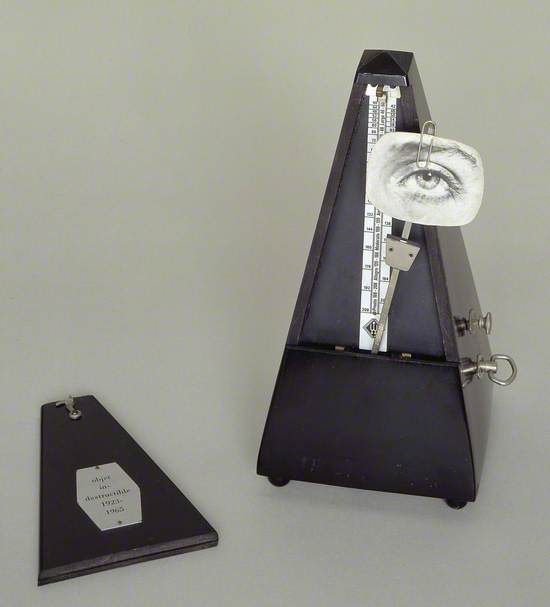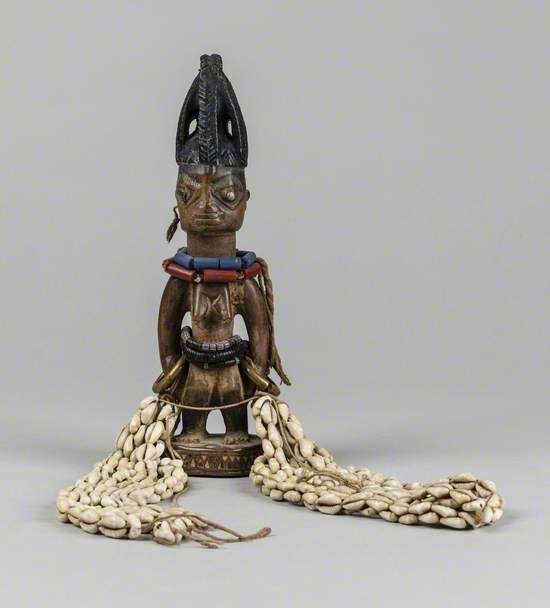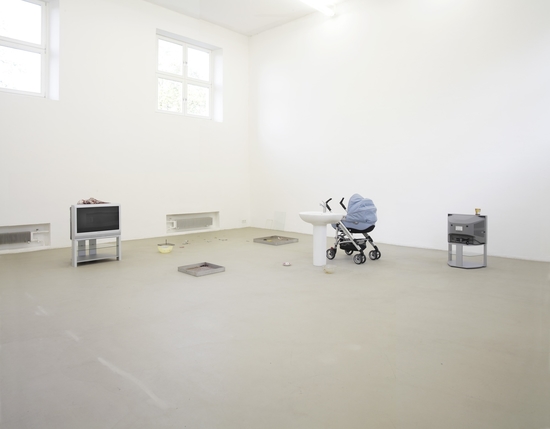Artists sometimes make art from unexpected objects - things we don't think of as art materials that originally had another function or purpose. These objects are called 'found objects'. Found objects can be manufactured, or objects from nature (such as stones, shells or bones). Sometimes they are used without making any changes to them, or an artist may decide to alter an object or use it alongside other materials. Explore some of the ways found objects have been used by artists.
Found objects and cubism
Pablo Picasso, Georges Braque and other Cubist artists started to include newspapers and other found objects and images in their paintings and sculptures at the beginning of the twentieth century. They often mixed these ‘real’ objects with objects painted to look real. In this still life painting, Juan Gris has included a real newspaper alongside a blind that has been painted to look real, making us question what we are looking at.
Juan Gris (1887–1927)
Gouache, collage, chalk and charcoal on canvas
H 92.1 x W 72.7 cm
Tate
Readymades
Marcel Duchamp invented the art term ‘readymade’ in around 1914 to describe the sculptures he began to make from found objects. He didn’t always change the objects in any way, but by giving them a title and presenting them in galleries, they became sculptures. His most famous readymade, made in 1917, was a ceramic urinal that he turned upside down and called Fountain.
Uncanny objects
In the 1920s and 1930s Surrealist artists often used found objects in their art. They were inspired by psychoanalyst Sigmund Freud’s theory of 'the uncanny'. The theory suggests that ordinary, everyday objects become unsettling or disturbing if presented in unexpected ways or placed in unexpected situations. By adding a photograph of an eye to a metronome, artist Man Ray has transformed it into a strangely unsettling object. Man Ray made the sculpture after his girlfriend, the photographer and model Lee Miller, left him. The insistent beat or pulse of the metronome, both irritating and unending, suggests the difficulty he had in forgetting her.
Man Ray (1890–1976)
Wooden metronome & photograph, black & white, on paper
H 21.5 x W 11 x D 11.5 cm
Tate
Powerful objects
Way before artists in Europe and America started using objects in artworks, African artists were using found objects in their sculptures. This Ibeji figure, made by by an unknown Yoruba artist, is adorned with glass beads, metal rings and strings of cowrie shells. Cowrie shells are thought to have a protective power and were originally a form of currency across Africa.
unknown artist
Wood, cloth, metal, glass & shells
H 36 x W 25.1 cm
Museum of Archaeology and Anthropology, University of Cambridge
Pop objects
In this sculptural relief, Peter Blake has used found letters from old signage as well as toys, books and other found objects. Peter Blake began using images and objects from everyday life and popular culture in his art in the early 1960s. Like many other young artists at that time, he felt that the things he saw around him – advertising, magazines, photographs of celebrities, product packaging – were far more interesting and relevant than the type of traditional fine art subjects and techniques that were being taught at art school. This type of art is called Pop Art because it was inspired by popular culture.
Peter Blake (b.1932)
Enamel, wood, paper & found objects
H 97.8 x W 156.8 x D 10.1 cm
Pallant House Gallery
Everyday Minimalism
Minimalist artists Carl Andre and Dan Flavin, working in the early 1960s, bought items such as bricks and fluorescent lights from DIY shops which they carefully arranged and presented as sculptures. They wanted to challenge the importance given to the art object. They also argued that by using ordinary, everyday materials their work would be more democratic and that anyone would be able to respond to it and enjoy it (not just a specialist art audience).
Objects and narratives
Cathy Wilkes also uses everyday found objects in her installations. But her installations have a very different feel to the fun and bright Pop sculptures. Wilkes uses the objects to evoke domestic situations. Familiar, functional objects take on a sense of melancholy as Wilkes arranges them to suggest empty rooms and imagined narratives, often relating to social deprivation and domestic situations that women find themselves in.
Cathy Wilkes (b.1966)
Televisions, aluminium trays, water, petrol, pram, sink, towel, phone, salad bowls, mirror, jar, battery, saucer, shoe, fabric, thread & paintings
Arts Council Collection, Southbank Centre
Nature into art
Andy Goldsworthy, like other land artists, makes sculptures directly in the landscape, using the natural objects found there. Goldsworthy has used stones, sticks and even ice and snow to make his sculptures. For Hearth Stone he has brought the landscape into the gallery. By scraping a square shape into the surface of a found rock, we see the rock in a different way. The orderly square shape makes us more aware of the rough, natural irregular form and surface of the rock. The sculpture is one of a series made by the artist to fit in the fireplaces of Pallant House Gallery in Chichester.
Objects as symbols
Damien Hirst also brings nature into the gallery and is perhaps best known for his shark, cows and sheep. Mother and Child Divided is comprised of four glass-walled tanks, containing the two halves of a cow and calf, each bisected and preserved in formaldehyde. In much of his work, Hirst explores themes of mortality and the fragility of life. By using formaldehyde he preserves the lifelike form of the animals. The sculpture, with its reference to a mother and child, also subverts one of the oldest icons of Western Christian art – the portrait of the Holy Mother and Child. Instead of the joyful unity of mother and baby, which the traditional image celebrates, Hirst presents a mother and child forever separated from one another.
Damien Hirst (b.1965)
Glass, stainless steel, perspex, acrylic paint, cow, calf & formaldehyde solution
Tate
Objects and meaning
Cornelia Parker has made several sculptures and installations from flattened silver objects. She said this about using these objects: 'silver is commemorative, the objects are landmarks in people’s lives. I wanted to change their meaning, their visibility, their worth, that is why I flattened them'. The title of this sculpture references Rorschach tests – psychological tests that involve asking people what ink blots formed by folding paper with ink trapped inside, remind them of. The symmetry of the flattened silverware is reminiscent of the blots of ink used in these tests. By making this connection, Parker is perhaps hinting at how we think about objects and what we associate them with.
Cornelia Parker (b.1956)
14 silver-plated objects crushed by 250-ton industrial press & suspended from wire
H 2.5 x W 426 x D 41 cm
Government Art Collection
Blurring boundaries
To make this sculpture, Hayley Tompkins used a chair and painted it with delicate dabs of pastel colour. She lists the materials she has used as ‘chair readymade and acrylic paint’, referencing Marcel Duchamp's use of found objects. But unlike Duchamp, she has used the found object as a surface to paint on. The function of the chair has changed (it is no longer just a functional thing to sit on); but also it has become an ambiguous artwork, sitting (excuse the pun!) somewhere between a sculpture and a painting.
Hayley Tompkins (b.1971)
Acrylic paint & chair readymade
H 81 x W 40 x D 45 cm
Rochdale Arts & Heritage Service
From rubbish to radiance
This might look like a string of giant fairy lights – but if you look closely you will see that the light 'shades' are in fact cheap plastic bottles and containers that have been lit up with bulbs. By adding lights to the throwaway containers, Batchelor has transformed them into something colourful and beautiful.
David Batchelor (b.1955)
20 plastic containers, low energy lights, electric cable & plug
H 177.5 x W 52 x D 28.5 cm
Government Art Collection
Objects and memories
Objects often have a personal significance for people, inspiring memories of events, places and people. Have you ever visited a social history museum and seen an object that reminded you of a toy you had as a child, or a place you once worked, or a visit to your granny? To make this sculpture – which is a bit like a tiny museum, on wheels – Hans K. Clausen asked people to donate objects. He hopes that these found objects will spark thoughts, memories and conversations. If you made a mini exhibition of objects that are important because of what they remind you of, what would you choose to include?
Hans K. Clausen (b.1964)
NHS Lothian Charity – Tonic Collection
Explore artists in this Curation
View all 13-
 Hans K. Clausen (b.1964)
Hans K. Clausen (b.1964) -
 Carl Andre (b.1935)
Carl Andre (b.1935) -
 David Batchelor (b.1955)
David Batchelor (b.1955) -
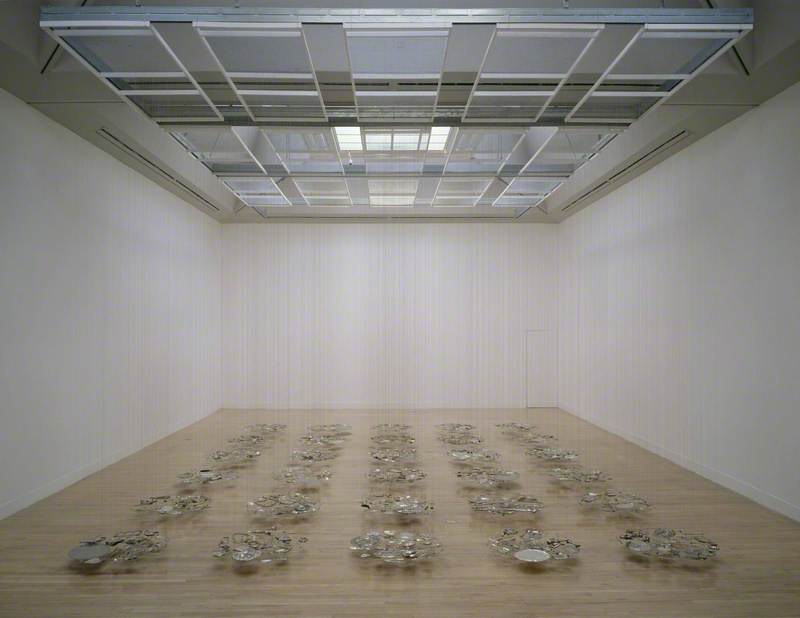 Cornelia Parker (b.1956)
Cornelia Parker (b.1956) -
 Cathy Wilkes (b.1966)
Cathy Wilkes (b.1966) -
 Damien Hirst (b.1965)
Damien Hirst (b.1965) -
 Marcel Duchamp (1887–1968)
Marcel Duchamp (1887–1968) -
 unknown artist
unknown artist -
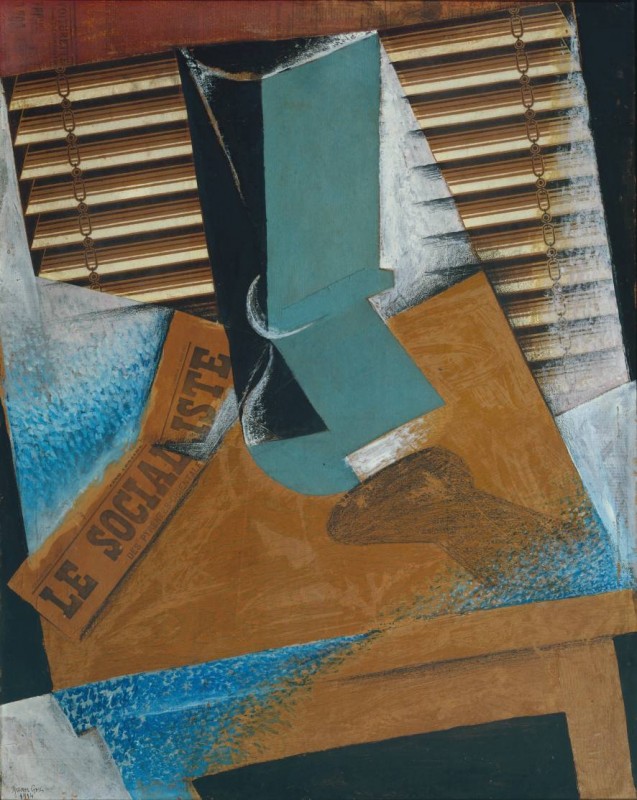 Juan Gris (1887–1927)
Juan Gris (1887–1927) -
 Peter Blake (b.1932)
Peter Blake (b.1932) - View all 13


